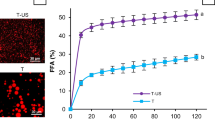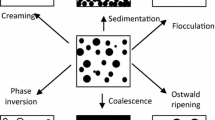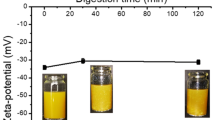Abstract
There is a constant need for novel and bioactive ingredients that can offer the ability to enhance and extend emulsion functionality. Inulin, an established prebiotic fiber, is finding increased use in various food products; however, it has poor performance as an emulsifier, thus, a hydrophobically modified inulin (HMI) has been developed. This research systematically evaluated the impact of HMI on emulsion functionality and susceptibility to key isolated components of human digestion.
Emulsion stability (assessed through analytical centrifugation), size and electrokinetic charge (assessed through laser scattering techniques) following high pressure homogenization indicate stable emulsions with sub-micro sized droplets (mean d4,3 = 0.55 ± 0.01 μm) can be obtained. Evaluation of emulsion stability to pH (2.0 < pH < 10.0) and CaCl2 (0–40 mM) highlight the extended emulsion functionality compared to simple emulsions, such as protein-stabilized emulsions. Further, emulsions were subjected to in vitro gastric or intestinal digestion as well as mixing with bile (0–25 mg/mL). These experiments suggest HMI does not alter emulsion susceptibility to bile yet improves emulsion stability to the dynamic conditions of the human stomach and accelerate intestinal lipolysis. Overall, this study shows the prospect of HMI in multifunctional emulsion systems intended for oral consumption. Such novel formulations could offer consumers controlled and targeted delivery of bioactives to the upper gastro-intestine and concomitantly offer additional potential benefits which could arise from the consumption of functionalized prebiotics.







Similar content being viewed by others
References
I. Siro et al., Functional food. product development, marketing and consumer acceptance-A review. Appl. Biochem. Microbiol. 51(3), 456–467 (2008)
R.C. Benshitrit et al., Development of oral food-grade delivery systems: current knowledge and future challenges. Food Funct. 3, 10–21 (2012)
McClements, D.J., Emulsion Design to Improve the Delivery of Functional Lipophilic Components, in Annu Rev Food Sci Tech. 2010, Annual Reviews: Palo Alto. p. 241–269.
K.P. Velikov, E. Pelan, Colloidal delivery systems for micronutrients and nutraceuticals. Soft Matter 4(10), 1964–1980 (2008)
D.J. McClements, Y. Li, Structured emulsion-based delivery systems: Controlling the digestion and release of lipophilic food components. Adv Colloid Interfac 159(2), 213–228 (2010)
D. Mudgil, S. Barak, Composition, properties and health benefits of indigestible carbohydrate polymers as dietary fiber: a review. Int. J. Biol. Macromol. 61, 1–6 (2013)
K.M. Tuohy, Inulin-type Fructans in healthy aging. J. Nutr. 137(11), 2590S–2593S (2007)
A. Benichou, A. Aserin, N. Garti, Protein-polysaccharide interactions for stabilization of food emulsions. J Disper Sci Technol 23(1–3), 93–123 (2002)
B. Chen, D.J. McClements, E.A. Decker, Role of continuous phase anionic Polysaccharides on the oxidative stability of menhaden oil-in-water emulsions. J Agr Food Chem 58(6), 3779–3784 (2010)
M.S. Katsuda et al., Physical and oxidative stability of fish oil-in-water emulsions stabilized with beta-lactoglobulin and pectin. J Agr Food Chem 56(14), 5926–5931 (2008)
T. Tokle et al., Impact of dietary fiber coatings on behavior of protein-stabilized lipid droplets under simulated gastrointestinal conditions. Food Funct. 3, 58–66 (2012)
U. Lesmes, D.J. McClements, Controlling lipid digestibility: Response of lipid droplets coated by [beta]-lactoglobulin-dextran Maillard conjugates to simulated gastrointestinal conditions. Food Hydrocoll 26(1), 221–230 (2012)
T. David-Birman, A. Mackie, U. Lesmes, Impact of dietary fibers on the properties and proteolytic digestibility of lactoferrin nano-particles. Food Hydrocoll. 31(1), 33–41 (2013)
G. Shimoni et al., Emulsions stabilization by lactoferrin nano-particles under in vitro digestion conditions. Food Hrdrocoal 33(2), 264–272 (2013)
Meshulam, D. and U. Lesmes, Responsiveness of emulsions stabilized by lactoferrin nano-particles to simulated intestinal conditions. Food Funct., 2013
C.M. Oliver, M.A. Augustin, L. Sanguansri, Maillard-based casein-carbohydrate microcapsules for the delivery of fish oil: emulsion stability during in vitro digestion. Aust J Dairy Technol 64(1), 80–83 (2009)
J. O'Regan, D.M. Mulvihill, Heat stability and freeze-thaw stability of oil-in-water emulsions stabilised by sodium caseinate-maltodextrin conjugates. Food Chem. 119(1), 182–190 (2010)
B.S. Chu et al., Modulating pancreatic lipase activity with Galactolipids: Effects of emulsion interfacial composition. Langmuir 25(16), 9352–9360 (2009)
G.R. Gibson, Prebiotics as gut microflora management tools. J Clin Gastroenterol 42(6), S75–S79 (2008)
S. Macfarlane, G.T. Macfarlane, J.H. Cummings, Review article: prebiotics in the gastrointestinal tract. Aliment Pharm Therap 24(5), 701–714 (2006)
Elad, A.M. and U. Lesmes, Nutritional Programming of Probiotics to Promote Health and Well-Being, in Probiotics, E. Rigobelo, Editor. 2012, InTech
M. Roberfroid, Dietary fiber, inulin, and oligofructose: A review comparing their physiological effects. Crit Rev Food Sci 33(2), 103–148 (1993)
T.F. Tadros et al., Stabilisation of emulsions using hydrophobically modified inulin (polyfructose). Colloid Surface A 250(1–3), 133–140 (2004)
M. Nedyalkov et al., Wetting properties of aqueous solutions of hydrophobically modified inulin polymeric surfactant. Colloid Polym. Sci. 286(6–7), 713–719 (2008)
D. Exerowa et al., Oil-in-water emulsion films stabilized by polymeric surfactants based on inulin with different degree of hydrophobic modification. Colloids and Surfaces a-Physicochemical and Engineering Aspects 334(1–3), 87–91 (2009)
G. Gotchev et al., Interaction forces in thin liquid films stabilized by hydrophobically modified inulin polymeric surfactant. 3. Influence of Electrolyte Type on Emulsion Films. Langmuir. 23(11), 6091–6094 (2007)
Aken, G.A.v., M.H. Vingerhoeds, and R.A.d. Wijk, Textural perception of liquid emulsions: Role of oil content, oil viscosity and emulsion viscosity. Food Hydrocoll., 2011. 25 (4): p. 789–796
T. van Vliet et al., Colloidal aspects of texture perception. Adv Colloid Interfac 150(1), 27–40 (2009)
C.V. Stevens et al., Polymeric Surfactants Based on Inulin, a Polysaccharide Extracted from Chicory. 1. Synthesis and Interfacial Properties. Biomacromolecules 2(4), 1256–1259 (2001)
S.J. Hur, E.A. Decker, D.J. McClements, Influence of initial emulsifier type on microstructural changes occurring in emulsified lipids during in vitro digestion. Food Chem. 114(1), 253–262 (2009)
A. Sarkar, K.K.T. Goh, H. Singh, Colloidal stability and interactions of milk-protein-stabilized emulsions in an artificial saliva. Food Hydrocoll 23(5), 1270–1278 (2009)
D. Lerche, T. Sobisch, Direct and accelerated characterization of formulation stability. J Disper Sci Technol 32(12), 1799–1811 (2011)
H. Singh, A.Q. Ye, D. Horne, Structuring food emulsions in the gastrointestinal tract to modify lipid digestion. Prog. Lipid Res. 48(2), 92–100 (2009)
A. Sarkar, K.K.T. Goh, H. Singh, Colloidal stability and interactions of milk-protein-stabilized emulsions in an artificial saliva. Food Hydrocolloids 23(5), 1270–1278 (2009)
M. Hu et al., Role of calcium and calcium-binding agents on the lipase digestibility of emulsified lipids using an in vitro digestion model. Food Hydrocoll. 24(8), 719–725 (2010)
Y. Li, M. Hu, D.J. McClements, Factors affecting lipase digestibility of emulsified lipids using an in vitro digestion model: Proposal for a standardised pH-stat method. Food Chem. 126(2), 498–505 (2011)
C. Shani-Levi, S. Levi-Tal, U. Lesmes, Comparative performance of milk proteins and their emulsions under dynamic in vitro adult and infant gastric digestion. Food Hydrocoll. 32(2), 349–357 (2013)
P.J. Wilde, B.S. Chu, Interfacial & colloidal aspects of lipid digestion. Adv Colloid Interfac 165(1), 14–22 (2011)
Y. Li, M. Hu, D.J. McClements, Factors affecting lipase digestibility of emulsified lipids using an in vitro digestion model: Proposal for a standardised pH-stat method. Food Chem. 126(2), 498–505 (2011)
M.H. Vingerhoeds et al., Relating the effect of saliva-induced emulsion flocculation on rheological properties and retention on the tongue surface with sensory perception. Food Hydrocoll 23(3), 773–785 (2009)
McClements, D.J., Food Emulsions: Principles, Practice, and Techniques. Contemp Food Sci. 2005, Boca Raton, FL: CRC Press
K.A. Karraker, C.J. Radke, Disjoining pressures, zeta potentials and surface tensions of aqueous non-ionic surfactant/electrolyte solutions: theory and comparison to experiment. Adv. Colloid Interface Sci. 96(1–3), 231–264 (2002)
Acknowledgments
The authors would like to acknowledge the technical support of the Lorry I. Lokey Interdisciplinary Center for Life Sciences and Engineering and the financial support of the Russell Berrie Nanotechnology Institute. Ms. Dafna Meshulam would like to thank the generous support of the Joan and Erwin Jacobs scholarship during her M.Sc. research.
Author information
Authors and Affiliations
Corresponding author
Additional information
Equal Contribution of D. Meshulam and J. Slavuter
Rights and permissions
About this article
Cite this article
Meshulam, D., Slavuter, J. & Lesmes, U. Behavior of Emulsions Stabilized by a Hydrophobically Modified Inulin Under Bio-Relevant Conditions of the Human Gastro-Intestine. Food Biophysics 9, 416–423 (2014). https://doi.org/10.1007/s11483-014-9353-4
Received:
Accepted:
Published:
Issue Date:
DOI: https://doi.org/10.1007/s11483-014-9353-4




